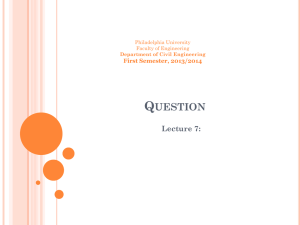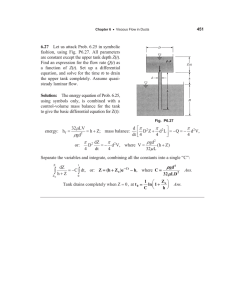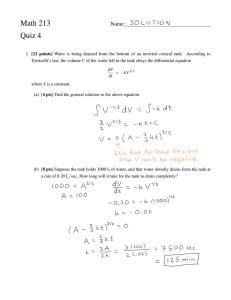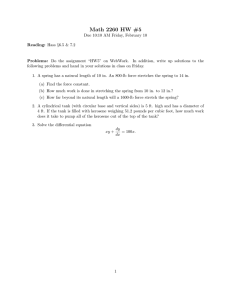Rainwater Harvesting System With Surface Spring As - eeecos-2016
advertisement
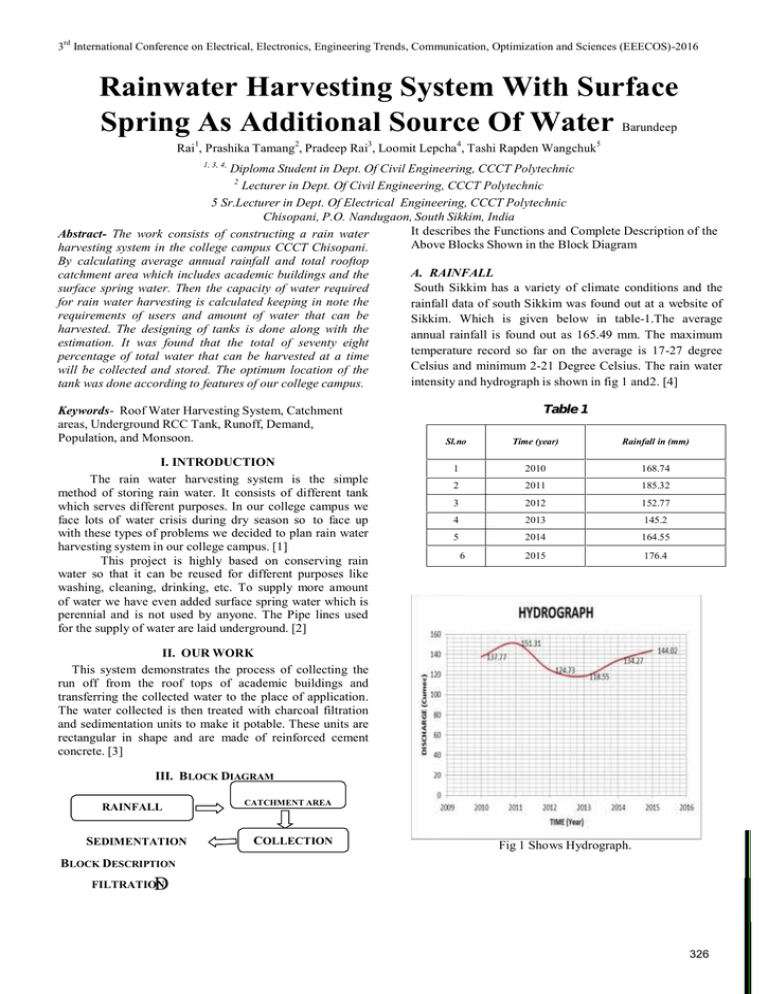
3rd International Conference on Electrical, Electronics, Engineering Trends, Communication, Optimization and Sciences (EEECOS)-2016 Rainwater Harvesting System With Surface Spring As Additional Source Of Water Barundeep Rai1, Prashika Tamang2, Pradeep Rai3, Loomit Lepcha4, Tashi Rapden Wangchuk5 1, 3, 4, Diploma Student in Dept. Of Civil Engineering, CCCT Polytechnic 2 Lecturer in Dept. Of Civil Engineering, CCCT Polytechnic 5 Sr.Lecturer in Dept. Of Electrical Engineering, CCCT Polytechnic Chisopani, P.O. Nandugaon, South Sikkim, India It describes the Functions and Complete Description of the Abstract- The work consists of constructing a rain water Above Blocks Shown in the Block Diagram harvesting system in the college campus CCCT Chisopani. By calculating average annual rainfall and total rooftop A. RAINFALL catchment area which includes academic buildings and the South Sikkim has a variety of climate conditions and the surface spring water. Then the capacity of water required for rain water harvesting is calculated keeping in note the rainfall data of south Sikkim was found out at a website of requirements of users and amount of water that can be Sikkim. Which is given below in table-1.The average harvested. The designing of tanks is done along with the annual rainfall is found out as 165.49 mm. The maximum estimation. It was found that the total of seventy eight temperature record so far on the average is 17-27 degree percentage of total water that can be harvested at a time Celsius and minimum 2-21 Degree Celsius. The rain water will be collected and stored. The optimum location of the intensity and hydrograph is shown in fig 1 and2. [4] tank was done according to features of our college campus. Keywords- Roof Water Harvesting System, Catchment areas, Underground RCC Tank, Runoff, Demand, Population, and Monsoon. I. INTRODUCTION The rain water harvesting system is the simple method of storing rain water. It consists of different tank which serves different purposes. In our college campus we face lots of water crisis during dry season so to face up with these types of problems we decided to plan rain water harvesting system in our college campus. [1] This project is highly based on conserving rain water so that it can be reused for different purposes like washing, cleaning, drinking, etc. To supply more amount of water we have even added surface spring water which is perennial and is not used by anyone. The Pipe lines used for the supply of water are laid underground. [2] Table 1 Sl.no Time (year) Rainfall in (mm) 1 2010 168.74 2 2011 185.32 3 2012 152.77 4 2013 145.2 5 2014 164.55 2015 176.4 6 II. OUR WORK This system demonstrates the process of collecting the run off from the roof tops of academic buildings and transferring the collected water to the place of application. The water collected is then treated with charcoal filtration and sedimentation units to make it potable. These units are rectangular in shape and are made of reinforced cement concrete. [3] III. BLOCK DIAGRAM RAINFALL SEDIMENTATION CATCHMENT AREA COLLECTION Fig 1 Shows Hydrograph. BLOCK DESCRIPTION D FILTRATION 326 3rd International Conference on Electrical, Electronics, Engineering Trends, Communication, Optimization and Sciences (EEECOS)-2016 Fig 2 Shows Annual Rainfall Graph B. CATCHMENT AREA The catchment area for this project consists of roof top area of academic buildings. These comprises of GI Sheets roof top of area 134.719 m2.These can collect water upto 134.719 × 1000=1, 34,719.2 Ltrs at a time of rainfall. The catchment area is shown in fig 3. [1] Fig.4 COLLECTION TANK D. SEDIMENTATION The water from the collection tank is supplied to sedimentation unit. The sedimentation unit comprises a rectangular RCC structure, the reinforcement used is of size 12mm main bars and 8mm distribution bars .it also consist of screening chamber which will trap the floating matters present in water with two baffle wall. The first baffle wall is constructed to trap the heavy sediments present in the collected water, after trapping the sediments the debris is flushed out by flushing outlet. The second baffle wall is constructed little smaller than the first one which will trap the small sediments and the clean water is supplied to next unit through outlet pipes as shown in fig 5. [5] Fig 3:- PLAN AND LAYOUT OF SITE C. COLLECTION Collection unit comprises of a rectangular tank of volume 35.52 m3 which is constructed with reinforce cement concrete and it’s laid Semi underground i.e. 30cm above ground. This tank collects rain water from catchment area of academic buildings through the pipes and gutters and then the water is passed to sedimentation tank as shown in fig 4 .[5] Fig.5 SEDIMENTATION TANK E. FILTRATION The filtration unit comprises of RCC structure which is placed above ground. The volume of filtration tank is 24m3.The filtration media used are wire mesh, charcoal, gravel and pebble and these method is termed as charcoal filtration these tank collects water from sedimentation tank and is passed to storage tank through pipelines. It follows the process of slow sand filter where the water passes through wire mesh, charcoal, gravel and pebble to remove debris, suspended particles and dirt from water before entering the storage tank through outlet pipe as shown in fig 6. [6] 327 3rd International Conference on Electrical, Electronics, Engineering Trends, Communication, Optimization and Sciences (EEECOS)-2016 Fig.6 FILTRATION TANK F. STORAGE The storage tank is a RCC structure which is a semi underground. This tank can store water upto 70,000 litres. The water after passing through all the tanks gets purified and is stored in storage tank so that the water is used only in the dry days(i.e. during scarcity of water).as shown in fig7.[6] Fig.7 STORAGE TANK G. QUANTITIES FOR DIFFERENT TANK UNITS The quantity of different work that is to be carried out during the implementation of this project is given below in the table. [7] SI.NO 1 2 3 4 5 6 7 8 9 10 11 DESCRIPTION Earthwork in excavation Stone soling / Gravel PCC in foundation Plaster RCC in foundation RCC in main wall RCC in slab 12mm plaster in outer wall 12mm plaster in inner wall Baffle Walls Baffle walls VOLUME OF WORK 77.908 m3 50.34 m3 29.29 m3 70.62 m2 11.172 m3 8.92 m3 26.72 m3 65.38 m2 57.66 m2 0.27 m2 0.15 m2 IV. RESULT AND ANALYSIS The amount of water harvested is found to be 1,34,719.2 Ltrs during rainy season and the designed storage tank is of capacity 70,000 ltrs (max.) and 35520ltrs (max) in collection tank. Total of 78.31 % of water is stored and collected in these tanks. In case of low rainfall, tanks can be recharge by perennial surface run source which supplies 432 ltrs per day. The amount of water harvested is found to be sufficient for 300-400 heads during dry season. So, after analysing the results it is found that this project would be helpful during water crisis. This project is 80% reliable on rainfall and 20% on the surface source. The water sample is practically tested in labs where we found the turbidity of sample as 8.6NTU (Nephlometric Turbidity Unit) and after treating with the rapid sand filter we found the turbidity as 3.4NTU. The normal drinking water should not exceed 5NTU and hence our sample lies within the limitations of potable water. As per the experiment we found that the Ph (Potential of Hydrogen) value of our sample as 6.91 which is not classified as potable water. So we took the sample and filtered through the rapid sand filter and found the Ph value of that particular water as 7.34 which are good for drinking purpose also. After passing through filtration unit the water gets into storage tank where it gets treated with some amount of alum which will make the water as potable. V. CONCLUSION This work got many advantages as it can be used as the alternative source for the water supply. Most importantly this project can be implemented as the backup source and brings a lot of productivity in everyday life. This project is the ultimate solution for the water crises situations as it collects about 73.81% of rain water. The design of filtration and sedimentation tank would help in purifying water which can be used even for drinking purposes. By implanting this project at our collage, the shortage of water will be fullfill.There won’t be any water scarcity during summer or dry season. This project cannot be completed without the hard work of our team mate and our guide. This project has helped also with knowledgeable information which are useful and applicable in future. Future Scope Reduces demand on ground water. Reduction of water bills. Can be Used for Several Non-drinking Purposes Reduces water scarcity. Development of college. 328 3rd International Conference on Electrical, Electronics, Engineering Trends, Communication, Optimization and Sciences (EEECOS)-2016 REFERENCE [3] [ 1] Ustav R.Patel, Vikrant A. Patel Manjurali I.Balya, Harshad M, [ 2] [ 3] [ 4] [ 5] [ 6] [ 7] [ 8] [ 9] Rajgor “roof top rain water harvesting (RRWH) at SPSV campus Vsnagur: Gujarat-A Case study .eISSN:2319- 1163/pISSN: 23217308. Vol:3 Issue 4/April 2014. D.N Pandey, A.K Gupta and D.M Anderson, “Rainwater harvesting as an adaptation to climate change”, current science, Vol: 85, no 1, pp46-59, 2003. “Guidance on the use of rain water tanks” agriculture water management,vol-5,pp.145-158,1982 H.N.Verma and P.B.S.Sarma,”design of storage tank for water harvesting in rained areas ”,Agricultural water management,Vol:18,pp.195-207,1990 “Hydrology and runoff computation, irrigation engineering & Hydraulic structure”. R. N. Athavale, “Water harvesting and sustainable supply in India,” Centre for Environment Education, Ahmedabad, India, 2003. C. A. David, “Guidance on the use of rainwater tanks,” National Environmental Health Forum Monographs Water Series, Australia, No. 3, 1998. A. K. Goel and R. Kumar, “Economic analysis of water harvesting in a mountainous watershed in India,” Agri-cultural Water Management, Vol. 71, pp. 257–266, 2005. Sadia Rahman,1 M. T. R. Khan,2 Shatirah Akib,1 Nazli Bin Che Din,2 S. K. Biswas,3 and S. M. Shirazi4 “Sustainability of Rainwater Harvesting System in terms of Water Quality” Volume 2014 (2014), Article ID 721357. Authors: [1] Barundeep Rai is a final year Diploma student, Dept. of Civil Engineering from Centre for Computer and Communication Technology, Chisopani, South Sikkim. E mail- barundeep96@gmail.com [2] Pradeep Rai is a final year Diploma student, Dept. of Civil Engineering from Centre for Computer and Communication Technology Chisopani, South Sikkim. E mail- pradeepbantawarai99@gmail.com [4] Loomit Lepcha is a final year Diploma student, Dept. of Civil Engineering from Centre for Computer and Communication Technology Chisopani, South Sikkim. E mail- lepchaloomit@gmail.com [5] Tashi Rapden Wangchuk is presently associated with the Department of Electrical and Electronics Engineering at Centre for Computer and Communication Technology (CCCT-Govt. Polytechnic) Chisopani, South Sikkim, India as a Senior Lecturer since 2004 till date. Presently, he is the Academic Incharge of the college. E mail –tashirapden@gmail.com Prashika Tamang is presently associated with the Department of Civil Engineering at Centre for Computer and Communication Technology (CCCT-Govt. Polytechnic) Chisopani, South Sikkim, India as a Lecturer since 2011 till date. Presently, she is the Course Incharge of Civil Department. E mail –prashika20@rediffmail.com 329
